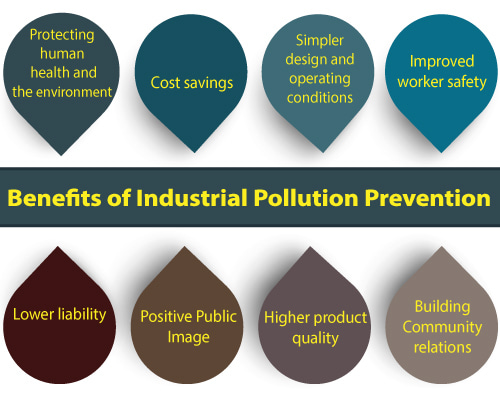Integrating pollution prevention into your industrial waste management system is essential for not only preventing land and air contamination but also reducing the burdens, liabilities, and organizational risks associated with waste management. Facility managers, state regulators, and members of the general public are often in the dark about effective waste management and are looking to improve their strategies while cutting costs and improving worker safety.
How is Industrial Waste Managed?
Industrial waste management includes segregation, land application (composting), landfill, and recycling of waste. Let’s break those terms down:
- Segregation involves separating the waste by type for effective disposal.
- Land application or composting is when the waste is treated through biodegradation and added to the soil, which improves quality by adding more organic material.
- Landfill is the burying of waste that cannot be recycled or composted - this is the least preferred method of waste management because it results in the direct release of waste into the environment.
- Recycling is reusing or repurposing waste materials to reduce the amount of waste that is produced. All these processes also utilize various waste management technologies that are available within waste management facilities.
Methods of managing waste vary from facility to facility. Waste characterization is required to assess all the waste types that your facility produces, their level of production, and how you should properly manage them. The characterization process includes consulting experts such as:
- An engineer with high process knowledge.
- A member of the sampling team.
- A quality assurance representative.
These experts, among other professionals, have in-depth knowledge of inventory, processes, and products within your facility. They can provide accurate waste tracking for effective characterization. After the waste has been characterized, you are now able to formulate a good waste management strategy and optimize it for pollution prevention.
Why is Industrial Waste a Problem?
Industrial waste poses risks to both the environment and human health. It can cause contamination of soil, air, and water if it is not properly disposed of. This can also negatively impact human health, including the health of the workers in your facility.
In 1998, workers in an electronics plant located in Oregon were found to have been exposed to a carcinogenic chemical through the factory’s drinking water. The chemical trichloroethylene (TCE) was used for degreasing in the facility paint shop. It was found in very high concentrations well above the regulated levels due to improper disposal. Drums of degreasing waste from the paint shop were dumped on the ground, and they seeped into the facility’s water supply well. The factory was shut down for cleanup.
Dumping of waste had not yet been regulated and was still a method of disposal in various industries. The company did not have access to the best information on waste management and was uninformed about the effects of dumping waste on their plant. Gaining information on effective waste management practices can help you prevent incidents such as this one and keep you from harming your employees or being shut down.
What is Pollution Prevention?
Pollution prevention, as defined by The federal government of Canada, is the use of processes, practices, materials, or energy that minimize the creation of pollutants and waste to reduce the overall risk to the environment or human health. The Pollution Prevention Act of 1990 ranked the methods of pollution prevention as source reduction, recycling, followed by combusting for energy recovery, treatment, and releasing the chemical waste into the environment in an environmentally safe manner, with the most preferred being source reduction and the least being disposal into the environment.
The benefits of implementing the above-mentioned methods go beyond government requirements and compliance. Large automotive companies such as General Motors, Honda, Subaru, and more have generated billions from their efforts to become landfill-free by recycling and reducing waste. Even if you don’t have a billion dollars to recover from your waste, pollution prevention methods are worth pursuing and can greatly benefit your company in the following ways:

Your first step to creating an effective pollution prevention strategy is to evaluate your current processes and identify parts that can be improved using some industry and regulatory best practices. We’ll outline the technical strategies that will be detailed in the following section.
Incorporating Pollution Prevention in Industrial Waste Management
The three elements of pollution prevention in relation to industrial waste management include source reduction, recycling, and waste treatment. The image below shows the various stages of pollution prevention in order of preference to ensure as much shift from disposal as possible.
.jpg?width=329&name=The-industrial-waste-management-hierarchy_graph-1%20(1).jpg)
Figure 1: The industrial waste management hierarchy according to the Pollution Prevention Act of 1990 provided by the Environmental Protection Agency (EPA) in their industrial waste management guide.
Source reduction is the first line of defense for pollution prevention. It aims to eliminate the amount of waste produced before recycling, treatment, or disposal and to reduce risk to public health. When thinking about source reduction, it is important to ensure that your method will not affect waste generation in any other process during manufacturing. Many manufacturing companies employ various methods of source reduction that enhance their waste management strategy:
- Technological modification, such as upgrading equipment, is an effective way of reduction. For example, a paint manufacturing company replaced its four-tank cartridge filler with one that completely empties the source tanks to prevent industrial waste disposal of the ‘bottom of tank’ materials.
- Having a clean, organized facility and effective inventory control also works well. Some aircraft manufacturing plants replace their single-walled vertical tanks with double-walled horizontal tanks, which significantly reduces accidents from chemical spills and, in turn, reduces the waste generated by the plant.
- Reformulating and redesigning your required materials. For instance, using alternate materials with lower-risk waste is a way to ensure that less waste is generated. For example, some medical instrument manufacturers have substituted Lead with non-leaded compounds in their PCB manufacturing. While this may not be a possibility for you, it is important to think of points in manufacturing where these changes can be made without affecting waste production in other stages.
These examples barely scratch the surface of how source reduction can be implemented in facilities. Other methods include good housekeeping procedures, reformulating dyes and paints, maintenance, inspections, inventory control, minimal on-site inventory, and effective waste segregation. It is essential that you find a method that is good for your facility.
Recycling is the second most impactful method of pollution prevention that you can implement in your industrial waste management system. This includes in-process recycling, such as reusing water, finding alternate uses for recycled items, and optimizing your raw materials at other stages. Our recommendations include charging recyclers for dedicated recycling loads instead of mixed loads to create more revenue and sending back packaging components such as dunnage to the supplier for reuse.
Waste treatment is the least preferred method of pollution prevention, but it is still extremely useful. This is the practice of changing the properties of industrial hazardous waste and making it less harmful. This includes physical treatment, chemical treatment, and biological treatment.
- Physical treatment changes the physical properties (size, shape, or state) of the waste but does not affect the chemical properties.
- Chemical treatment alters the chemical composition of the waste by treating it with different chemicals that cause various reactions.
- Biological treatment is when the waste is exposed to organisms that can decompose organic components into simpler organic products and biomass. The organisms can break down the waste in the presence or absence of oxygen, aerobic or anaerobic, respectively.
Examples of these categories of waste treatment are represented in the image below. They can be used both individually and/or combined to warrant a reduction in the volume and toxicity of waste before disposal. You can choose the methods that apply to the type and volume of waste that is produced in your facility.
.jpg?width=625&name=Types-of-Industrial-Waste-Treatment-1%20(1).jpg)
Exploring Waste Management Technologies
All this information seems daunting at first glance, but the benefits mentioned above are worth generating an effective waste management strategy that incorporates pollution prevention. In order to ensure your processes are effectively improving safety and/or cutting down on chemical releases, you can consider implementing automation tools to help with effective tracking. If you would like to learn more about how you can track your waste efficiently to start your pollution prevention journey, we recommend watching the video below. It shows how you can use ERA’s waste management software to manage generation, storage, shipment, treatment, reporting, reuse, and industrial waste disposal in your facility.
Effective Strategies for Waste Management
Managing waste is an important part of an Environmental Manager’s portfolio – one that can be complicated and full of compliance risk. Companies are required to maintain comprehensive records, meet waste reporting deadlines, and responsibly manage their waste or face noncompliance penalties. Failing to comply with EPA, OSHA, and RCRA regulations can negatively impact the reputation of a company and may result in the company being shut down by regulators and do tremendous damage to your corporate reputation. Spreadsheets for waste management may help environmental managers keep up with the avalanche of data, but spreadsheets have their limitations; when data is incorrect, the consequences can be serious for companies reporting to federal and state regulators. Waste management relies on many processes, waste calculations, container tracking, and record-keeping for accurate reporting. In the event of a computer crash, the waste management data should still be accessible – an assurance that spreadsheets cannot promise.
Tracking Waste
Mistakes are often made in tracking waste at facilities – it’s one of the easiest places to overlook small details that have a big impact. Common mistakes made by organizations include:
- tracking waste in data silos
- tracking waste for only annual reports but not providing waste credits for monthly air emission reporting
- excluding non-hazardous waste from annual waste reports and TRI (Toxic Release Inventory Reporting).
Often, these common waste management issues are related to how you track your data. Using spreadsheets tends to encourage thinking in data silos and not seeing the connection between data sets for different reports. The consequences of waste tracking mistakes can result in inconsistent reports—catching the attention of regulators, resulting in fines, and the loss of the reputation of the company in the public eye. Eliminate the use of spreadsheets and inconsistent waste tracking with environmental management software.
ERA’s Waste Hazardous Management Software automates waste tracking. Facilities can manage the entire life cycle of waste disposal. Use our software to:
- Request empty containers
- Request approval
- Generate and print labels
- Deliver containers to the site
- Request transfer of full containers
- Confirm transfers
- Weigh containers at accumulation
- Ship to the treatment site
You can also make your waste tracking faster and easier with software safeguards against human error to flag mistakes on the fly. Incomplete data or incorrect reporting can also signal to government regulators that you may be non-compliant. Waste data can be entered just once to create various reports—including TRI, annual/biennial waste (GM), emission inventory, and air emission reports for consistent waste tracking.
Waste Speciation
Accurate waste speciation is another challenge for facilities generating a great deal of chemical waste. Oftentimes, drum containers are “black boxes” with unknown chemical quantities and mixtures. Companies can draw a sample for lab analysis to complete a waste profile, but there are drawbacks to frequent sampling: lab sampling can be very expensive, and it may show a false representation of waste and operations due to process changes, making the lab results obsolete for reporting. Inaccurate waste profiles can lead to penalties for your facility, so rely on a system with various methods of calculating waste speciation for proper emission crediting and correct speciation. Waste can be measured in various ways using ERA’s methodologies to ensure accurate reporting tracking waste throughout the assembly process. Based on the available information about your waste, there are different options for calculations that could be used by the software to estimate the composition of the waste, depending on the users’ choice and available information about the waste and source(s).
- Single source waste: In a very simple way, if the waste is added to a single source, the software will look at the products (and their chemical constituents) used in that source as well as their usages and come up with an estimate of the waste constituents and their amounts.
- Fixed distribution: if the waste is added against a group of sources, the user can define a fixed distribution in the group (set up in an air module) (in the finishing module), and the system will use the same percentage to distribute the waste quantity to each source. In other words, waste records are linked to certain sources (or source groups), and based on user-defined distributions, the composition is calculated.
Example: Your waste group is made up of a paint source and a solvent source, and you define 80% to be allocated to the paint source and 20% to the Solvent source. When you add 100 gallons of waste to the group, the system will allocate 80 gal to the paint source and 20 gal to the solvent, based on the defined percentages.
- Distribution by Usage: In this method, the system will take the usage of products in each source, within the time frame the waste is added, as the base for waste distribution calculations.
On-site and Off-site Waste Management
Tracking waste management on-site and off-site manifests can be very tedious for Environmental managers. With time-sensitive container management rules and tons of other responsibilities, tasks, and reports can often get lost or stuck waiting for approvals. EHS Waste management software can:
- Notify responsible parties for container orders via email.
- Keep track of time waste has been in satellite and accumulation areas.
- Reminders for reporting deadlines.
- Cost tracking of treatment and transportation of the waste.
Environmental managers can fulfill their compliance requirements and keep up with tracking containers on and off-site automatically with software built to accommodate facilities. Managers and facilities benefit from using a secure, centralized database with standardized processes for entering and recording data. Having a centralized database equipped with access “tiers” with managers given full access and other employees given access only to their database tasks organizes task assignments and pending deadlines. We encourage EHS professionals to handle their waste management demands with software designed for their unique needs and work processes for greater efficiency, accuracy, and compliance.
Next Steps for Effective Waste Management and Pollution Prevention
You can take your organization’s pollution prevention to the next level with ERA’s Hazardous Waste Managing Software. Tackle all of your reporting and waste tracking needs and benchmark waste generation, treatment, storage, testing, and disposal. You’ll benefit from a full range of tools for managing both hazardous and non-hazardous waste. Streamline communications, task assignment, and progress monitoring to ensure efficient and effective waste management.
Interested in hearing more about what ERA’s software can do for you? Schedule a discovery call with one of our project analysts today.
This Blog was Co-Authored By:


Tags:
Waste Management
November 4, 2020
Comments